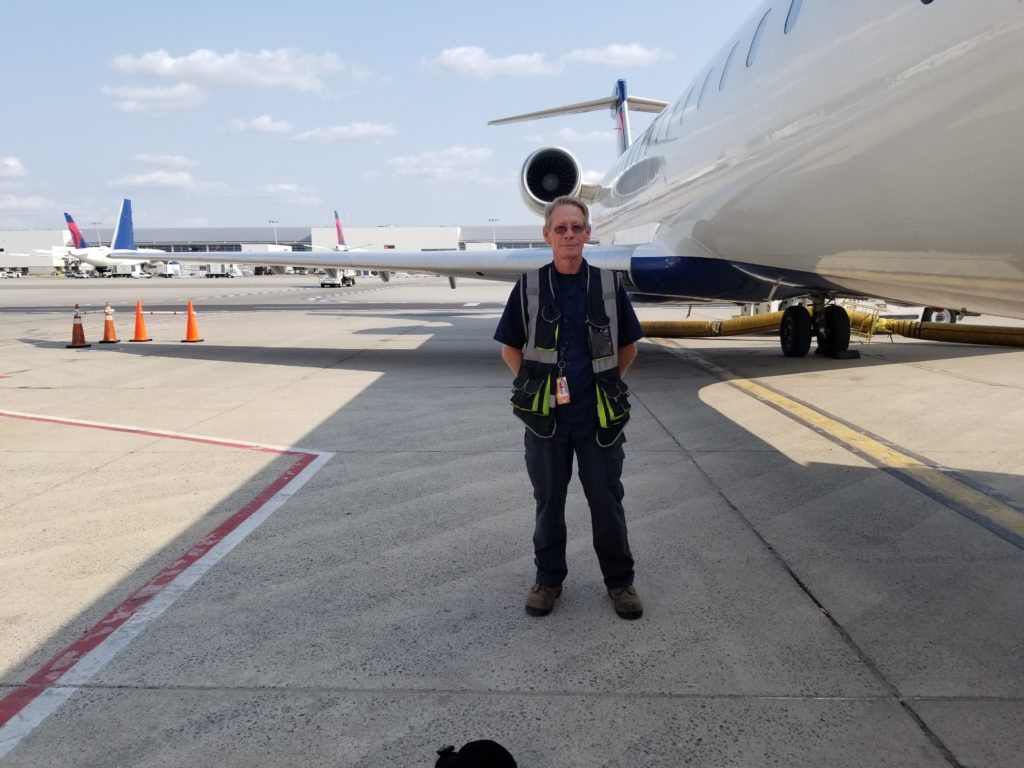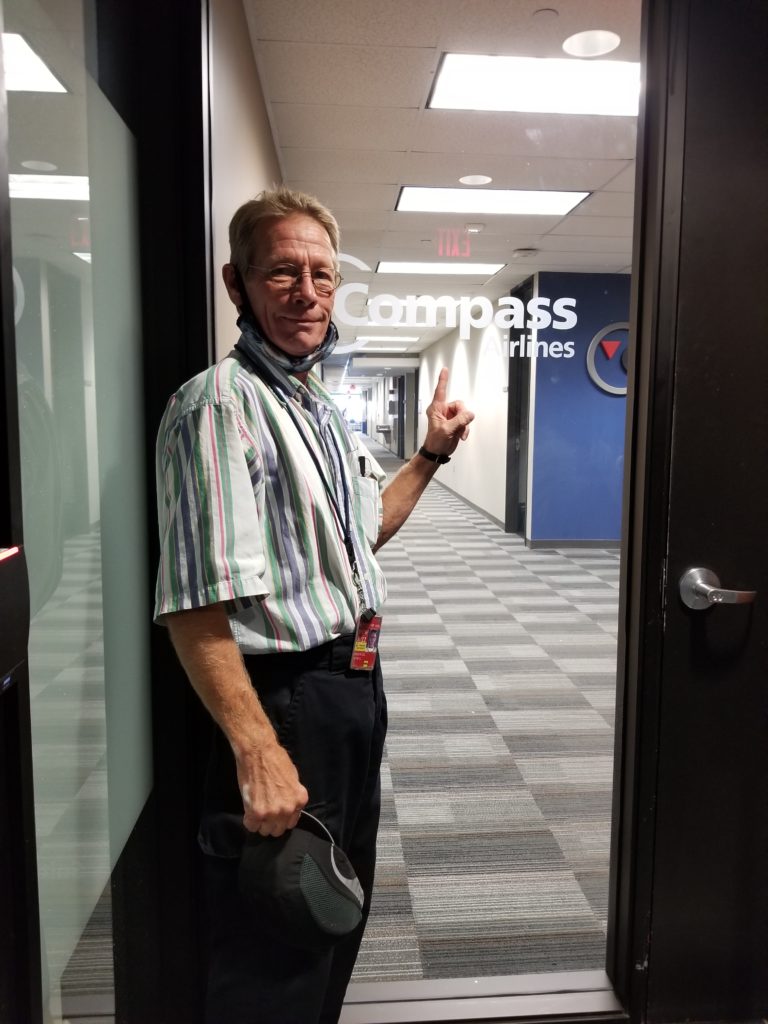
Since 1974, Trade Adjustment Assistance (TAA) has prepared American workers for new jobs after they were laid off due to unfair trade. But it expired on June 30, leaving thousands in the lurch.
When Kim Brewer lost his steel mill job at McLouth Steel in 1996 at the age of 40, he didn’t know what he was going to do with the rest of his life. He had worked for 20 years at the Detroit area steel mill. Suddenly, he found himself out of the only profitable work he knew how to do.
But this isn’t where Brewer’s story ends.
With the help of Trade Adjustment Assistance (TAA), a federal government program that provides benefits and retraining for workers who were laid off because their employer was adversely affected by increased imports from other countries, Brewer was able to learn a new trade and successfully find another career path.

For the past 23 years, Brewer has excelled at his new job as an aircraft mechanic, a skill he learned while going through the TAA program after his sudden layoff.
“When you go back to school it is a whole different game,” Brewer said. “It’s not high school, it’s not grade school, you are going there to become a person that’s going to be employed by a company whatever that trade is, and you have to work toward it.
“You can’t just sit there and look out the window. You’ve got to be educated to get through it, and the TAA gave me the opportunity. As far as the program goes, I have nothing but praise for it. It changed my life. Without that program who knows what I would be doing right now. I sure wouldn’t be doing this.”
Brewer’s successful career story is one of many garnered by workers who suddenly found themselves out of work through no fault of their own, but rather to the corporate offshoring of production. TAA is designed to help workers whose factory jobs moved overseas as companies looked for cheap labor outside the United States. It provides financial subsidies for retraining, extended unemployment insurance benefits, job search assistance, and health coverage tax credits.
But unfortunately, funding for the TAA program expired on June 30, and workers who lost their jobs because of trade are no longer eligible. Because Congress allowed the program to expire, any worker who lost their job after July 1 can no longer apply for an application of these retraining services.
That means if a company closes a factory in the United States and ships jobs overseas, the workers will be on their own.
Approximately 100,000 people signed up for TAA each year, and more than 5 million American workers have used the program since its inception in 1974, according to the Labor Department. Federal funding for the TAA program is estimated to have been about $750 million per year, a small amount in the grand scheme of government funded programs.
In 2021, the Department of Labor certified 801 petitions for trade adjustment assistance, covering an estimated 107,000 American workers.
The TAA program allowed workers to receive retraining and job certifications in many different careers. People that went through TAA were able to acquire advance degrees, including associates, bachelor’s, and even master’s degrees. They were able to continue with their education while receiving extended unemployment insurance benefits.
In July, the Labor Department estimated that about 4,500 workers have missed out on TAA benefits since it lapsed. More than 75 percent of people who participate in the TAA program find a new job within in six months.
A study by the Federal Reserve Bank of New York in 2018 found that after 10 years, TAA-trained workers earned about $50,000 more than those that did not participate in the program.
Several Members of Congress are working to renew funding for TAA, which was at one time enjoyed bipartisan support. Sen. Sherrod Brown (D-Ohio) blamed Republican lawmakers for “holding TAA hostage” and said he would continue fighting to reauthorize the program.
“Republicans in Congress need to stop holding TAA hostage,” Brown told the Alliance for American Manufacturing. “They have sold out American manufacturing over and over by voting for trade deals and tax policy that send jobs overseas.
“TAA serves workers who have their lives upended through no fault of their own. It’s more workforce training dollars. I will continue fighting to reauthorize TAA with retroactive coverage and provide these workers with the support they deserve.”

Roy Houseman, legislative director of the United Steelworkers (USW), is a major advocate of the TAA program. Houseman himself received assistance through the program when the Montana paper mill he worked at shut down.
Houseman began working at the Smurfit Stone paper mill in Missoula, Montana in 2005, and lost his job when the mill ceased operations in 2009. Having already earned a bachelor’s degree, Houseman petitioned through TAA to further his education, and went on to earn his master’s degree at the University of Montana in Missoula.
“The mill went through bankruptcy, and on the back end of bankruptcy, they shut the mill down,” Houseman said. “For me, applying for TAA was not just for me, it was for the whole group. And knowing a lot of people at the mill did not have full schooling, and when you look at the data on TAA, the people that go into the program, over 50 percent don’t have a high school diploma of GED equivalent.
“When you have a workforce and the tenure of people that worked at the plant or facility that qualified for TAA, the tenure was 10 years on average. So, you’ve got a workforce that has been doing one thing or working at one plant on average of 10 years, and half of them don’t have high school equivalency, and TAA was this opportunity to really kind of boost their skills.
“Once you write up a little plan or work with your case manager on what you want to do, they helped you with schooling costs, unemployment insurance and all those things that are the basics of the program that allow you to earn while you learn and at the same time upscale. To me that was the gold standard of training programs.”
The TAA program requires a company wide petition to the federal government for worker qualification, and Houseman was a leader in helping his fellow workers who sometimes found the application process confusing. When his paper mill was shut down, he helped approximately 800 fellow workers navigate the program and has since helped more than 12,000 people qualify for the program.
“This was the most important federal job training program available, and we were doing everything we could when there was a big plant dislocation, or even a small one,” Houseman said. “If we could prove there was a trade impact, we would work to get those workers certified. We would do training for the staff so they would know what they had to look for.
“That is one of the big pieces we do in the office here because when you get workers certified into the program, they use it. They can really upscale their careers and there are so many great stories of workers getting reskilled and becoming nurses and mechanics and got those hard skills that are so much in demand. I’ve even had a member who became a helicopter pilot.
“Having a union there (USW) to be able to look at things from maybe a little bit higher level than just how am I going to get unemployment insurance has been useful and one of the important pieces of workers having an advocate. We were able to educate the affected workers about the TAA program which they may not have known much about this great opportunity.”
Ray Spangler has worked at Goodyear Tire facilities for 22 years, starting in Union City, Tennessee. When that plant shut down, he transferred to the Goodyear plant in Gadsden, Alabama. In 2020, the Alabama plant that once employed more than 4,000 people, closed its doors, citing affects from the COVID-19 pandemic. But much of its production was relocated to a factory in Mexico, as well as other facilities in the United States.

At the age of 51, Spangler was concerned about his future in the rubber industry, and decided to enroll in the TAA program. He was able to attend Wallace State Community College and studied for a new career in mechatronics.
Mechatronics is a 21st century version of mechanical engineering, a skill that is now highly valuable with so many changes in manufacturing of automobiles, aerospace and medical equipment. Spangler was able to attain his associates degree during a year-and-a-half program while receiving continued unemployment benefits through TAA.
“This is a wonderful program that helps so many displaced workers out there. People lose their jobs through no fault of their own and the TAA program is there to help,” Spangler said. “I don’t think enough people took advantage of the program, because when people are in their 50s, they think going back to school for retraining is a too much at that stage of their work careers.”
Although Spangler received his degree and several certifications in mechatronics, he ended up back at Goodyear. One month before he graduated, Goodyear offered him a job at its plant in Topeka, Kansas. On July 11 of this year, he decided to go back to Goodyear, leaving his wife and daughter behind at their home in Alabama.
“I have job security now, and I am here to see what happens,” Spangler said. “You never know what is going to happen with Goodyear, but I now know I am qualified to get a job in one of the Alabama auto plants if things don’t work out here.
“I am living with my aunt here in Topeka and I am just going to see how things go. I had 22 years in at Goodyear, so I thought I would give it one more try since I am vested and have my same benefits and salary. But it is a big relief knowing that if this doesn’t work out, I have the skills and training for a new career and don’t have to worry about employment. There are a lot of automobile manufacturers in Alabama, and I can go back and get a good job thanks to the TAA program.
“I can’t believe they have eliminated the TAA program. It is such a great help to displaced workers and is the kind of program I expect our government to provide. If some of these big corporations paid their share of taxes, it would easily fund this program that makes such a difference in the working man’s lives.”
Brewer, who trained to become an aircraft mechanic, said the “increase in income over my lifetime since I went through TAA and became an aircraft mechanic is substantial.”
“There is no doubt you can learn a new skill and tremendously increase your income through this program,” Brewer said. “I can’t believe it is no longer available. We need more job training help like this. It is honest work for those that want to work and put the time in. This is not a free handout. It increases the power of the middle class and is good for this country.”
And the USW’s Houseman points out the critical need for the new job skills in the 21st century.
“I think this idea that the job market is great still doesn’t highlight that there is still a lot of [turnover] in the market,” Houseman said. “Unemployment may be low, and you may be able to move to another job quickly, but I like to use semiconductors as a prime example.
“They are looking to build seven to 10 semiconductor plants, but the industry estimates that they are going to need somewhere between 70,000 to 90,000 trained workers at these fab plants. Well, if you’ve been working at a paper mill for example for 20 years, learning how to make semiconductors is a bit more of a higher skill level in some ways, and why not have more robust federal job training programs like TAA to make sure that people are able to get the skills needed to get into those new semiconductor type of jobs.
“It’s not just an immediate situation,” Houseman said. “It’s the future of American manufacturing and our ability to compete on the global stage.”
